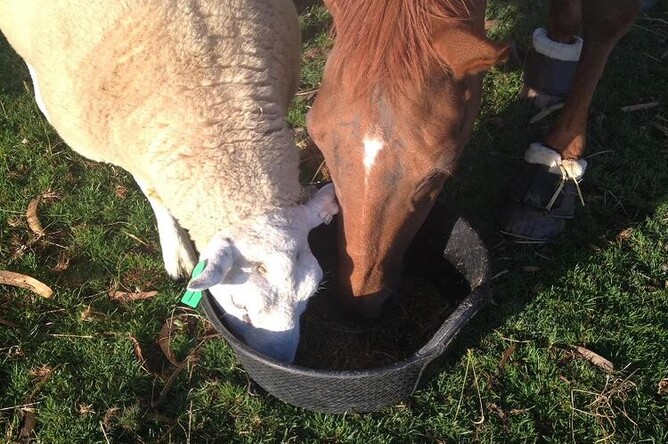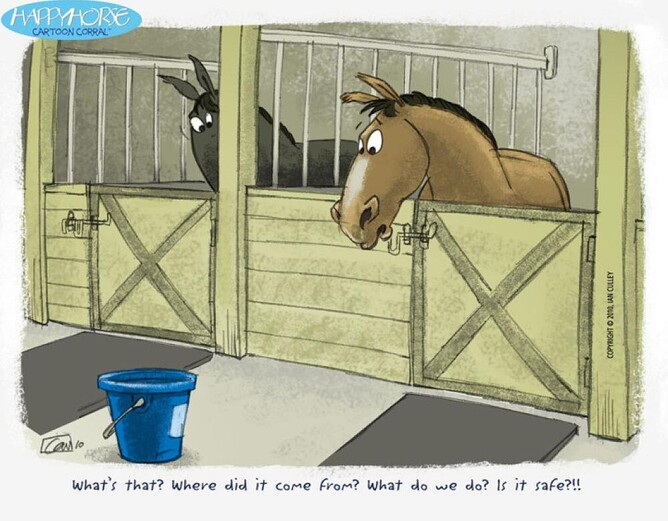What’s good for one species may be deadly for another!
Many of our horses live on properties that are shared with other animal species. The pet goat that steals the horse’s breakfast, the nosey sheep that licks the horse’s yummy molasses block, and the pokey pony that breaks out and finds his way into the calf feeders, are all too common.
Unfortunately, many formulated feeds are manufactured for a specific species, with additives selected for that animal's needs. For some animals, unintentional consumption of the wrong feed brings with it a risk of eating something toxic.
Supplementation of ewes or dairy calves with pelleted feed or meal is commonplace during the late winter and spring months. Many of these ‘processed feeds’ contain ionophores.
Monensin and Bovatec are ionophore antibiotics routinely used in the dairy, beef and sheep industry. They decrease the incidence of ketosis, improve feed efficiency, help control ruminal acidosis and reduce coccidia infections in young animals.
In the horse and other equids, however, ionophores are highly toxic.
Monensin is 10 times more toxic than Bovatec. Some feedstuffs and milk powders now contain Deccox (deqoquinate) which, fortunately, is considered less toxic to non-target species including horses, cats and dogs.
Symptoms to watch for
Signs of acute ionophore toxicity in horses include:
- Anorexia - the first and most consistent clinical sign, occurring within 24 hours of consumption
- Ataxia
- Colic
- Diarrhoea
- Trembling
- Increased heart rates (tachycardia)
- Signs of fulminant heart failure (i.e. coughing, jugular pulses, oedema and dyspnoea or breathing difficulties)
Blood tests can be performed to determine if there has been any damage to heart muscle.
A specific blood test – Cardiac troponin I (cTnI) - is a highly sensitive and specific biomarker of myocardial injury in horses. Horses may have mild elevations in cTnl, with most of the affected horses having neurologic signs without other evidence of cardiac muscle disease.
Cardiac damage from Monensin ingestion is dose-dependent. Horses that absorb smaller doses have a lower risk of developing cardiac disease.
A marked elevation in cTnl 48 hours after a horse has ingested the ionophore might indicate severe disease. Horses suffering from cardiac muscle damage may suffer from sudden death during exertion several weeks, or months, later. Follow-up blood tests are therefore required, and cardiac evaluation - including an electrocardiograph (E.C.G.) and heart ultrasound (Echocardiograph) - is often recommended.
How to treat affected horses
Unfortunately, there is no antidote for horses that have ingested an ionophore. However, administration of mineral oil and activated charcoal via a stomach tube may help it move through the system faster. This, along with supportive treatment with IV fluids and anti-inflammatories, will hopefully prevent some of the damage.
Common causes of contamination
Outbreaks of ionophore toxicity occur sporadically and are commonly associated with inadvertent access to calf or lamb meal.
Accidental contamination of horse feed during the milling and manufacturing process can also occur. Feed mills are generally very careful, but, if even a small amount of Monensin got mixed in with a batch of horse feed, it could be enough to kill horses that ate it.
Fortunately many horse feed mills only produce feed for horses so do not have any ionophores present in the mill.
Horses residing on dairy farms that have access to trough water are also likely to be at risk of receiving excessive amounts of trace elements (cobalt, selenium and copper) as well as potentially toxic bloat oils. That is because supplementation of trace elements and bloat oils through a reticulated water system is commonplace. A separate water trough for horses is therefore recommended.
While ionophore toxicity can be a problem for horses consuming ruminant feed, excessive consumption of horse feed by sheep can also have its problems.
Most formulated horse feeds and horse mineral blocks are fortified with additional copper specific for horses that may be considered too high for consumption by sheep, and this may result in copper toxicity. This is more problematic in certain breeds - mainly Texels in NZ.
Cats and dogs consuming calf or lamb meal or milk with additional coccidiostats are also at risk of being exposed to ionophores, so ensure that your bags are well sealed after opening.
Important prevention tips:
- Ensure products designated for calves, sheep and poultry are stored in a locked, secure shed and away from horse feed;
- Avoid putting horses into an area where other livestock are being supplemented with food containing ionophore additives;
- Use a horse feed specifically produced for horses and if possible from a mill that only produces horse feed;
- Read product labels carefully and talk to us for more information;
- Provide an alternate water source if your horse is on a farm with additives being added to the main water system.
If you have any concerns about whether a feed is suitable for horses, or suspect your horse has had access to calf or lamb feed, please do not hesitate to contact us at your nearest VetSouth clinic.
- Heather Busby


